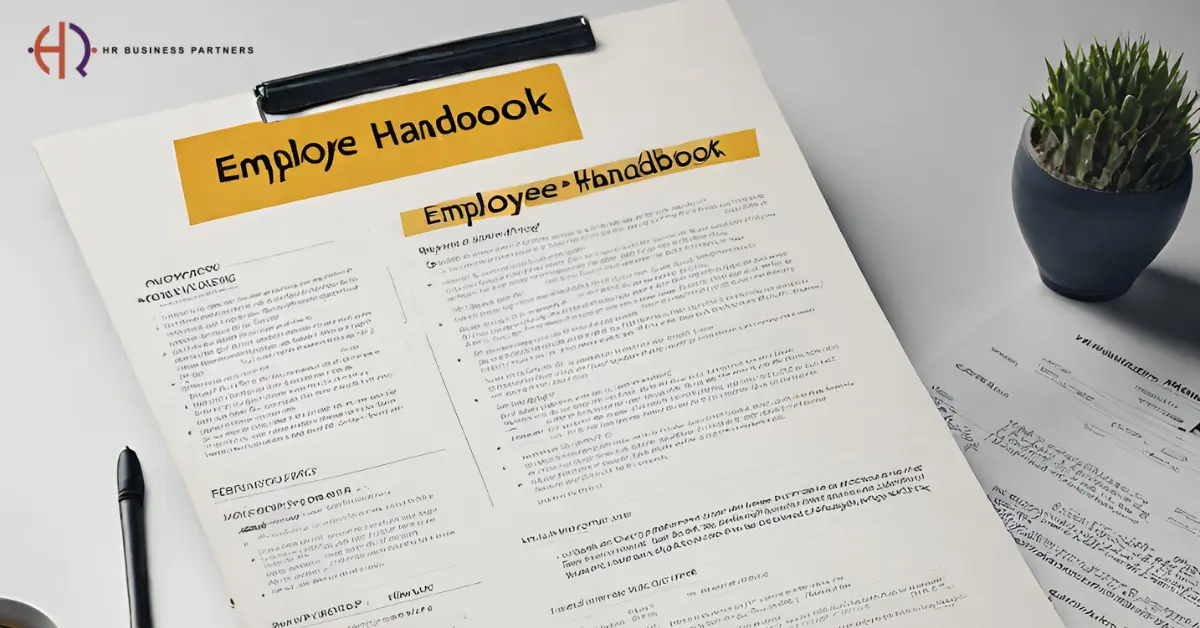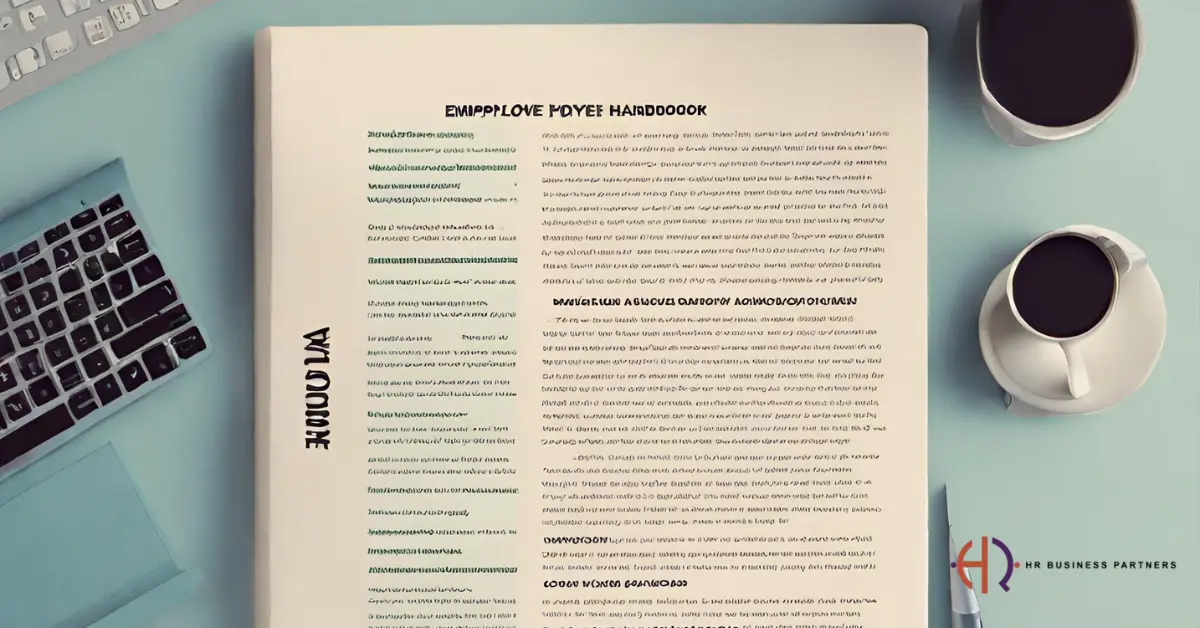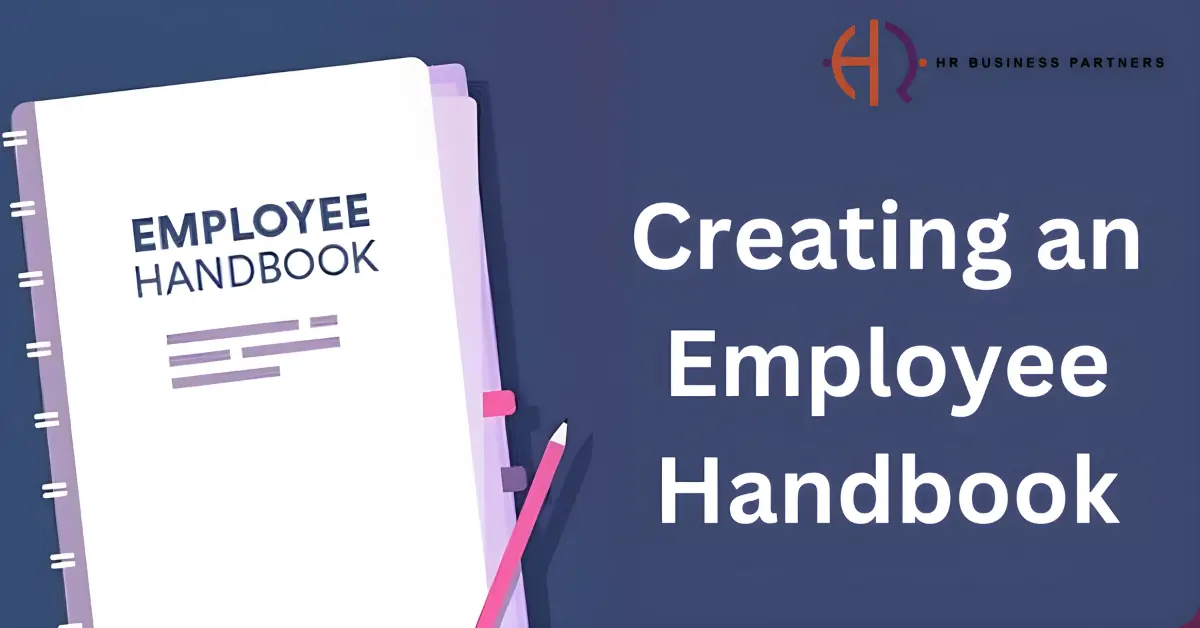Imagine stepping into a forest without a map. You’d likely feel lost, unsure of which path to take, right? This is how employees can feel on their first day at a job without a clear guide.
An employee handbook serves as a guide for businesses, showing the way in the business world. It’s not just a book; it’s the map of a company’s culture, values, and daily operations.
This guide is crucial, whether you’re a small business just starting or a big corporation wanting to streamline your processes. HR consulting for small businesses can benefit greatly from having a well-crafted employee handbook.
So, why is crafting an employee handbook a task worth your time and energy? For starters, it sets clear expectations. It’s like having a wise friend who whispers the dos and don’ts in your ear, ensuring you don’t stumble. It also builds a bridge of understanding between employers and employees, paving the way for a harmonious workplace.
Moreover, in a world where misunderstandings can turn into mountains, this handbook serves as a reference point to clear the air. It’s not just about rules; it’s about creating a sense of belonging and a shared journey towards common goals.
If you’re wondering how to create an employee handbook that reflects your company’s soul while keeping it engaging and easy to digest, you’re in the right place.
We’re about to embark on a journey through the ins and outs of crafting a handbook that not only informs but also inspires. So, buckle up, and let’s dive into the art of creating an employee handbook that will become the heartbeat of your workplace.

How to Create an Employee Handbook
Creating an employee handbook is like putting together a puzzle. Each piece is crucial; when they fit together just right, you get a clear picture of your company. Let’s walk through the steps to create this important document.
The first step is gathering essential information—think of this as collecting the puzzle pieces. You’ll need details about your company’s policies, benefits, and work procedures. This is the foundation of your handbook, and it’s important because it helps ensure everyone is on the same page from day one.
Next, we will define your company culture and values. This is about expressing your company’s heart and soul. It’s what makes your company unique and different from others. Employees who understand what you stand for are more likely to feel connected and committed to the same goals.
The third step is outlining legal obligations and compliance issues. This part is about keeping everyone safe and ensuring your company follows the rules. It includes things like equal employment opportunities, workplace safety, and other laws affecting your business. It’s crucial for protecting both the company and its employees.
Finally, drafting your handbook is where you bring it all together. This is when you take all the pieces you’ve gathered and start writing. Your goal is to create a clear, easy-to-read document covering everything from A to Z. It should be informative and reflect your company’s personality.
By following these steps, creating an employee handbook becomes straightforward. This handbook will serve as a guide, helping steer your team in the right direction and building a more vital, unified workforce.
Best Practices for Creating an Employee Handbook
Creating an employee handbook is like weaving a quilt that will give your team clarity and confidence. Adopting some best practices can make a difference in ensuring it serves its purpose well. Let’s explore these practices to help you create a handbook that becomes a cornerstone of your workplace culture.
Firstly, keeping the language simple and accessible is vital. Imagine talking to a friend. You wouldn’t use complex jargon or convoluted sentences. Your handbook should reflect this approach. Using straightforward language ensures that everyone, regardless of their background or role within the company, can understand the content. This inclusivity fosters a welcoming environment where all employees feel valued and understood.
Next, it’s crucial to design your handbook with flexibility in mind. Think of your company as a living, breathing entity that grows and evolves. Your handbook should be able to do the same. It’s vital to make sure that it can be easily updated. This way, as your company introduces new policies or adapts to changes in the law, your handbook remains relevant and up-to-date. Consider creating a digital version that can be easily amended and redistributed.
Lastly, the importance of involving a legal review for compliance must be balanced. This step is like having a safety net to catch any potential issues before they become problems. A legal professional can help ensure your handbook complies with federal, state, and local laws. This review helps your company and workers. It stops legal problems and helps everyone respect the rules.
When you use these tips for your employee handbook, you make a guide. This guide helps people understand and build your company’s culture.
How to Create an Employee Handbook for a Small Business
Creating an employee handbook for a small business is like crafting a custom-made suit. It needs to fit your business perfectly. Tailoring policies to fit your business size means considering what’s unique about your team and work environment. For small businesses, it’s about more than copying what the big players do. Instead, it’s about focusing on what makes your company tick and how your team works best together.
When tailoring policies, think about the day-to-day operations of your business. You might not need the complex policies that more giant corporations have, but you do need clear guidelines that cover the essentials. This includes work hours, dress code, sick leave, and how you handle customer service. It’s all about finding the right balance. You want your handbook to be thorough but not so dense that it’s hard to understand.
Resources for small business owners are more accessible than you might think. There are plenty of tools and guides designed just for you. These resources can help you understand the basics of what to include in your handbook and show you how to make it legally compliant without getting overwhelmed. Look for online templates, small business associations, and even local workshops to get started.
Remember, creating an employee handbook is an opportunity to describe what your company is all about. It’s not just a set of rules. It’s a way to welcome new employees into your business and show them what you stand for. With the right approach, your handbook will become crucial to your company’s culture.

Cost to Create an Employee Handbook: DIY vs. Professional Services
When it comes to creating an employee handbook, there are two main paths: doing it yourself (DIY) or hiring professional services. Each option has its own set of costs and benefits, and the right choice depends on your company’s needs, budget, and desired level of customization.
If you choose the DIY route, the cost might seem low. After all, you’re not paying for external help. However, it’s essential to consider the time and resources you’ll spend.
You’ll need to research, write, and design the handbook. This process requires a solid understanding of labor laws to ensure compliance, plus a good grip on your company’s policies and culture. The actual cost here is the time taken away from other business activities.
On the other hand, hiring professional services to create your employee handbook is a significant investment. Professionals bring expertise in labor laws, writing, and design, ensuring your handbook is compliant and engaging.
They can tailor the handbook to reflect your company’s unique culture and values. While this option involves a higher upfront cost, it saves time and could prevent costly legal mistakes.
Budgeting for your handbook is an essential step in the planning process. Whether you’re going DIY or hiring professionals, set a realistic budget considering all potential costs.
This includes your time (or your team’s time) for a DIY project or the fees for professional services. Remember, an employee handbook is an investment in your company’s future. It helps set the tone for your workplace, making it a resource worth investing in.
No matter which path you choose, creating an employee handbook is a crucial step in building a solid foundation for your company. With the right approach, you can make a handbook that serves as a valuable tool for your team, reinforcing your company’s values, culture, and expectations.
Create an Employee Handbook Online
In today’s digital age, creating an employee handbook online has become a go-to method for many companies. With various online tools and platforms at your disposal, putting together this crucial document has never been easier or more efficient. These digital resources offer templates, guidelines, and customizable options to help craft a handbook that perfectly captures your company’s essence and requirements.
The benefits of digital handbooks are vast. For starters, they are incredibly accessible. Employees can easily access the handbook from anywhere, at any time, whether they’re working remotely or need to reference a policy from the office. This accessibility ensures that all team members stay informed about company policies and updates in real time.
Another significant advantage is the ease of updating. Unlike printed handbooks, a digital version can be updated as needed without the hassle and expense of reprinting. This flexibility is crucial for keeping the handbook current with evolving company policies, legal requirements, and industry standards.
Moreover, digital handbooks are eco-friendly. Companies can lower their environmental impact by reducing the need for printed materials. It’s a small but meaningful way to contribute to sustainability efforts.
Creating an employee handbook online streamlines the process, making it more straightforward and flexible. It aligns with modern work environments, where digital access and sustainability are increasingly prioritized.
Whether revising an existing handbook or starting from scratch, going digital offers a practical, efficient path to ensuring your employees have all the information they need to succeed and thrive in your company.

Creating an Employee Handbook Template
Using a template can be a great starting point when creating an employee handbook. It’s like having a map when you’re exploring a new city. It gives you a sense of direction and ensures you cover all the essential landmarks—or, in this case, important company policies and procedures. However, relying solely on a template has its pros and cons.
One of the most significant advantages of using a template is that it can save you time. You won’t have to start from scratch. Templates often include sections on standard policies, benefits, and compliance issues, so you don’t have to worry about missing critical information. Conversely, the one-size-fits-all approach might not perfectly fit your company’s unique culture and values. That’s where customization comes into play.
Customizing your employee handbook is crucial. It’s your chance to infuse the document with your company’s personality. Start by reviewing the template and identifying areas where your company’s policies and practices can be highlighted. For example, if your company strongly emphasizes community involvement, add a section detailing your volunteer programs or community service days.
Remember, while templates are helpful, they’re just a guide. Your handbook should reflect what makes your company unique. Consider including a welcome message from the CEO or sharing stories that exemplify your company’s values. This personal touch can make the handbook more engaging and meaningful to your employees.
In conclusion, using a template for creating an employee handbook can be smart, but the customization truly brings it to life. Tailoring the content to reflect your company’s unique culture ensures that the handbook is not just a document but a reflection of what your company stands for.
Benefits of Creating an Employee Handbook
When we talk about creating an employee handbook, we’re diving into a powerful tool that goes beyond just a document. It’s a key player in fostering a transparent and open communication channel within your company. Think of it as a bridge that connects employees and management, ensuring everyone is moving in the same direction. By setting clear expectations, misunderstandings take a backseat, allowing for a smoother ride. This handbook lays out what’s expected of employees and highlights what they can expect from the company. It’s a two-way street that fosters mutual understanding and respect.
But the benefits continue beyond there. Another significant advantage of having an employee handbook is the legal protection it offers businesses. It’s like having a safety net that guards against potential legal hiccups. This document outlines your company’s policies on equal employment opportunities, harassment, and disciplinary actions. Should there ever be a dispute or misunderstanding, your handbook serves as a point of reference, demonstrating that your company takes its policies seriously and applies them consistently. This level of transparency and consistency is crucial in today’s work environment, offering the employer and employees peace of mind.
In sum, creating an employee handbook is more than just a task to check off your list. It’s an investment in your company’s future, ensuring smooth communication and legal compliance. This document is a testament to your commitment to a fair and transparent workplace, making it an indispensable resource for any business.
An Employee Handbook May Create a Contract
When you’re creating an employee handbook, it’s more than just putting words on paper. It’s about setting expectations and boundaries. However, there’s a twist not everyone considers: the legal side of things. Believe it or not, sometimes, a handbook can accidentally become a contract between you and your employees.
Understanding the legal implications is critical. When you lay out policies, benefits, and rules in your handbook, you make promises to your employees. If not worded carefully, these promises might be seen as binding, just like a contract. If there are changes or disagreements down the line, you might be legally held to what’s written in the handbook. It’s like telling someone you’ll do something; they expect you to stick to your word.
So, how do you avoid turning your handbook into an unintended contract? It’s all in the wording. First off, make it clear that the handbook is not a contract. This seems simple, but it’s a decisive step. Include a statement in the handbook that says it’s for informational purposes only and not a binding agreement. Also, use language that allows for flexibility. For instance, instead of saying “will” do something, it might be better to say “may” or “reserves the right to.” This way, you leave room for changes as your business grows and evolves.
Creating an employee handbook with these considerations in mind helps protect your business while providing clear guidance to your team. It balances setting clear rules and expectations with keeping the legal door closed on unintended contracts. This way, your handbook serves as a helpful guide without becoming a legal bind.
Frequently Asked Questions about Creating an Employee Handbook
1. What should be included in an employee handbook?
Answer: Your employee handbook should cover critical areas such as company culture, values, policies, employee benefits, work procedures, and legal obligations. It’s a guide that helps employees understand what’s expected of them and what they can expect from the company.
2. How often should the employee handbook be updated?
Answer: Reviewing and updating your employee handbook at least once a year is a good idea. This keeps it up-to-date with changes in company policies and any new laws or regulations that may affect your business.
3. Who should write the employee handbook?
Answer: Creating an employee handbook is a team effort. It often involves input from human resources, management, and sometimes even legal counsel to ensure all bases are covered. However, the writing should be clear and straightforward so everyone can understand it.
4. Do small businesses need an employee handbook?
Answer: Yes, even small businesses benefit from having an employee handbook. It sets clear expectations and helps protect the business in case of disputes. A handbook can also help foster a positive workplace culture, regardless of company size.
5. How can I make sure employees read and understand the handbook?
Answer: Make the handbook accessible and engaging to encourage employees to read it. Consider holding a meeting to review key points and answer any questions. It’s also helpful to require employees to sign a document stating they’ve received and read the handbook.

Conclusion
Creating an employee handbook might seem like just another task on the to-do list, but it’s much more than that. It’s a storytelling tool, a way to share your company’s journey and invite others to join in. Think of it as setting the stage for an adventure where every employee plays a crucial role. This employee handbook lays down the map, guiding employees through your company’s culture, values, and expectations. It’s where rules meet heart, combining the practical with the inspirational.
But here’s a thought: a handbook is not just a document; it’s a living, breathing part of your company. As your business evolves, so should your handbook. It should grow and change just like your team does. This dynamic approach keeps your company’s heart beating strongly, ensuring everyone is in sync and moving towards the same horizon.
Remember that creating an employee handbook is not just about dotting the i’s and crossing the t’s. It’s about weaving the fabric of your company’s culture into a document that resonates with every team member. So, take this opportunity to reflect on what makes your company unique and how you can share that with your employees. Because at the end of the day, a company’s true strength lies in its people, and an employee handbook is a powerful way to honor that truth.


